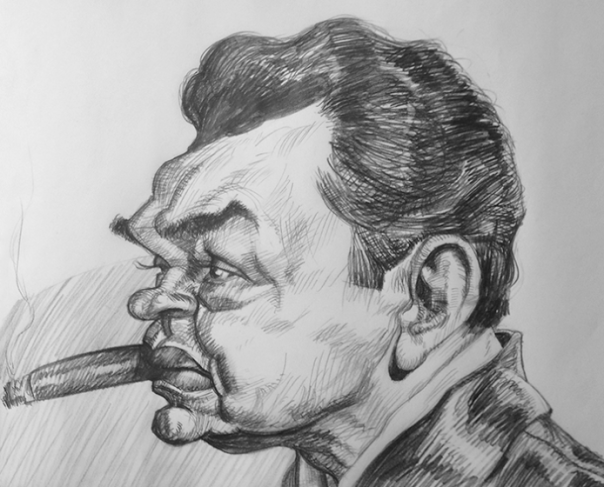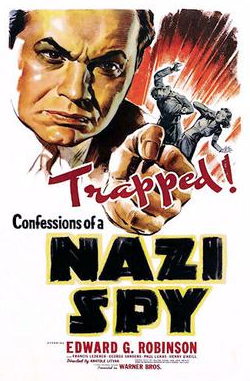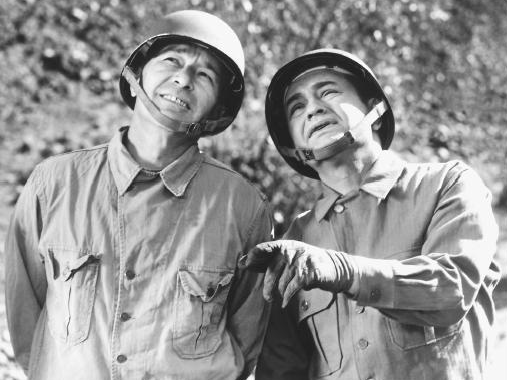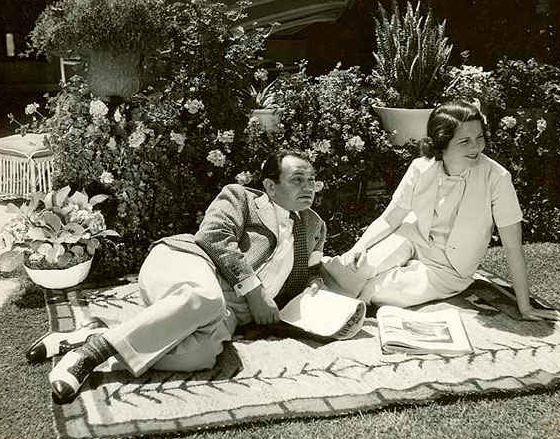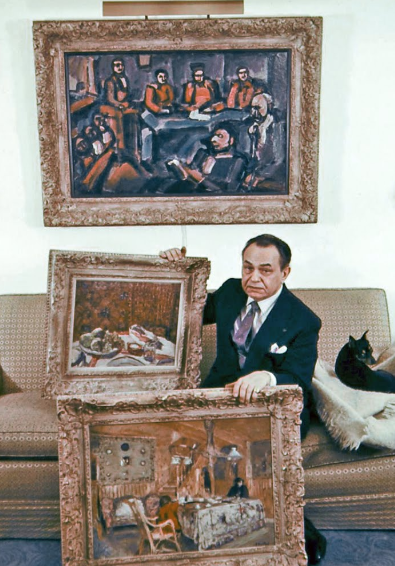Introduction
Edward G. Robinson (born Emanuel Goldenberg; December 12, 1893 – January 26, 1973) was a Romanian-American actor of stage and screen during Hollywood’s Golden Age. He appeared in 40 Broadway plays and more than 100 films during a 50-year career and is best remembered for his tough-guy roles as gangsters in such films as Little Caesar and Key Largo.
During the 1930s and 1940s, he was an outspoken public critic of fascism and Nazism, which were first growing in strength in Europe and led up to World War II. His activism included contributing over $250,000 to more than 850 organizations involved in war relief, along with cultural, educational and religious groups. During the 1950s, he was called to testify at the House Un-American Activities Committee during the Red Scare, but was cleared of any Communist involvement.
Robinson’s character portrayals have covered a wide range, with such roles as an insurance investigator in the film noir Double Indemnity, Dathan (adversary of Moses) in The Ten Commandments, and his final performance in the science-fiction story Soylent Green. Robinson received an Honorary Academy Award for his work in the film industry, which was awarded two months after his death in 1973. He is ranked number 24 in the American Film Institute‘s list of the 25 greatest male stars of Classic American cinema.
Early years and education
Robinson was born as Emanuel Goldenberg to a Yiddish-speaking Romanian Jewish family in Bucharest, the son of Sarah (née Guttman) and Morris Goldenberg, a builder.
After one of his brothers was attacked by an anti-semitic mob, the family decided to immigrate to the United States. Robinson arrived in New York City on February 21, 1904. “At Ellis Island I was born again,” he wrote. “Life for me began when I was 10 years old.” He grew up on the Lower East Side, had his Bar Mitzvah at First Roumanian-American Congregation, and attended Townsend Harris High School and then the City College of New York, planning to become a criminal attorney. An interest in acting and performing in front of people led to him winning an American Academy of Dramatic Arts scholarship, after which he changed his name to Edward G. Robinson (the G. standing for his original surname).
He served in the United States Navy during World War I, but was never sent overseas.
Career
Robinson began his acting career in the Yiddish Theater District in 1913 and made his Broadway debut in 1915. He made his film debut in Arms and the Man (1916).
In 1923 made his named debut as E. G. Robinson in the silent film, The Bright Shawl.
He played a snarling gangster in the 1927 Broadway police/crime drama The Racket, which led to his being cast in similar film roles, starting with The Hole in the Wall (1929) with Claudette Colbert at Paramount. Paramount kept him on for a comedy, The Kibitzer (1930).
One of many actors who saw his career flourish in the new sound film era rather than falter, he made only three films prior to 1930, but left his stage career that year and made 14 films between 1930 and 1932.
Robinson went to Universal for Night Ride (1930) and MGM for A Lady to Love (1930) directed by Victor Sjöström. At Universal he was in Outside the Law (1930) and East Is West, then he did The Widow from Chicago (1931) at First National.
Robinson was established as a film actor. What made him a star was an acclaimed performance as the gangster Caesar Enrico “Rico” Bandello in Little Caesar (1931) at Warner Bros.
Robinson signed a long term contract with Warners. They put him in another gangster film, Smart Money (1931), his only movie with James Cagney. He was reunited with Mervyn LeRoy, director of Little Caesar, in Five Star Final (1931), playing a journalist, and played a Tong gangster in The Hatchet Man (1932).
Robinson made a third film with LeRoy, Two Seconds (1932) then did a melodrama directed by Howard Hawks, Tiger Shark (1932). Warners tried him in a biopic, Silver Dollar (1932), where Robinson played Horace Tabor, a comedy, The Little Giant (1933) and a romance, I Loved a Woman (1933). Robinson was then in Dark Hazard (1934), and The Man with Two Faces (1934).
He went to Columbia for The Whole Town’s Talking (1935), a comedy directed by John Ford. Sam Goldwyn borrowed him for Barbary Coast (1935), again directed by Hawks.
Back at Warners he did Bullets or Ballots (1936) then he went to Britain for Thunder in the City (1937). He made Kid Galahad (1937) with Bette Davis and Humphrey Bogart.
MGM borrowed him for The Last Gangster (1937) then he did a comedy A Slight Case of Murder (1938).
He and Bogart were in The Amazing Dr. Clitterhouse (1938), then he was borrowed by Columbia for I Am the Law (1938).
In 1939, at the time World War II broke out in Europe, he played an FBI agent in Confessions of a Nazi Spy, the first American film which showed Nazism as a threat to the United States.
He volunteered for military service in June 1942 but was disqualified due to his age at 48, although he became an active and vocal critic of fascism and Nazism during that period.
MGM borrowed him for Blackmail (1939) then he played Paul Ehrlich in Dr. Ehrlich’s Magic Bullet (1940) and Paul Julius Reuter in A Dispatch from Reuter’s (1940), both biographies of prominent Jewish public figures. In between he and Bogart were in Brother Orchid (1940).
Robinson was teamed with John Garfield in The Sea Wolf (1941), and George Raft in Manpower (1941). He went to MGM for Unholy Partners (1942) and made a comedy Larceny, Inc. (1942). Robinson was one of several stars in Tales of Manhattan.
He did war films including Destroyer (1943) at Columbia, and Tampico (1944) at Fox. At Paramount he was in Billy Wilder‘s Double Indemnity (1944) with Fred MacMurray and Barbara Stanwyck; at Columbia he was in Mr. Winkle Goes to War (1944); he was opposite Joan Bennett and Dan Duryea in Fritz Lang‘s The Woman in the Window (1944) and Scarlet Street (1945).
At MGM he was in Our Vines Have Tender Grapes (1945), then did Orson Welles‘ The Stranger (1946) with Welles and Loretta Young. Robinson followed it with a thriller The Red House (1947) and starred in an adaptation of All My Sons (1948).
Robinson appeared for director John Huston as gangster Johnny Rocco in Key Largo (1948), the last of five films he made with Humphrey Bogart and the only one in which Bogart did not play a supporting role.
He went on to be in Night Has a Thousand Eyes (1948), and House of Strangers (1949).
Robinson found it hard to get work after his blacklisting. He was in low budgeted films: Actor’s and Sin (1952), Vice Squad (1953), Big Leaguer (1953), The Glass Web (1953), Black Tuesday (1954), The Violent Men (1955), Tight Spot (1955), A Bullet for Joey (1955), Illegal (1955), and Hell on Frisco Bay (1955).
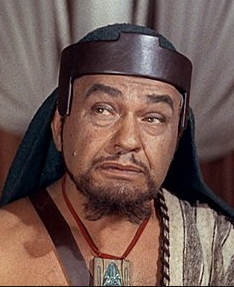 His career rehabilitation received a boost in 1954, when noted anti-communist director Cecil B. DeMille cast him as the traitorous Dathan in The Ten Commandments. The film was released in 1956, as was his psychological thriller Nightmare.
His career rehabilitation received a boost in 1954, when noted anti-communist director Cecil B. DeMille cast him as the traitorous Dathan in The Ten Commandments. The film was released in 1956, as was his psychological thriller Nightmare.
After a subsequent short absence from the screen, Robinson’s film career—augmented by an increasing number of television roles—restarted for good in 1958/59, when he was second-billed after Frank Sinatra in the 1959 release A Hole in the Head.
Robinson went to Europe for Seven Thieves (1960). He had support roles in My Geisha (1962), Two Weeks in Another Town (1962), Sammy Going South (1963), The Prize (1963), Robin and the 7 Hoods (1964), Good Neighbor Sam (1964), Cheyenne Autumn (1964), and The Outrage (1964).
 He had a key part in The Cincinnati Kid (1965) and was top billed in The Blonde from Peking and Grand Slam (1967).
He had a key part in The Cincinnati Kid (1965) and was top billed in The Blonde from Peking and Grand Slam (1967).
Robinson was originally cast in the role of Dr. Zaius in Planet Of The Apes (1968), and even went as far to filming a screen test with Charlton Heston. However, Robinson dropped out from the project before production began citing heart problems and concerns over the long hours under the heavy ape make up. He was replaced by Maurice Evans.
Later appearances included The Biggest Bundle of Them All (1968), Never a Dull Moment (1968), It’s Your Move (1968), Mackenna’s Gold (1969), and the Night Gallery episode “The Messiah on Mott Street” (1971).
The last scene Robinson filmed was a euthanasia sequence, with friend and co-star Charlton Heston, in the science fiction cult film Soylent Green (1973); he died only twelve days later.
Heston, as president of the Screen Actors Guild, presented Robinson with its annual award in 1969, “in recognition of his pioneering work in organizing the union, his service during World War II, and his ‘outstanding achievement in fostering the finest ideals of the acting profession.'”
Robinson was never nominated for an Academy Award, but in 1973 he was awarded an honorary Oscar in recognition that he had “achieved greatness as a player, a patron of the arts and a dedicated citizen … in sum, a Renaissance man.” He had been notified of the honor, but died two months before the award ceremony, so the award was accepted by his widow, Jane Robinson.
Robinson also did radio work. From 1937 to 1942, he starred as Steve Wilson, editor of the Illustrated Press, in the newspaper drama Big Town. He also portrayed hardboiled detective Sam Spade for a Lux Radio Theatre adaptation of The Maltese Falcon.
Personal life
Robinson married his first wife, stage actress Gladys Lloyd, born Gladys Lloyd Cassell, in 1927; she was the former wife of Ralph L. Vestervelt and the daughter of Clement C. Cassell, an architect, sculptor and artist. The couple had one son, Edward G. Robinson, Jr. (a.k.a. Manny Robinson, 1933–1974), as well as a daughter from Gladys Robinson’s first marriage. In 1956 he was divorced from his wife. In 1958 he married Jane Bodenheimer, a dress designer professionally known as Jane Arden. Thereafter he also maintained a home in Palm Springs, California.
In noticeable contrast to many of his onscreen characters, Robinson was a sensitive, softly-spoken and cultured man, who spoke seven languages. Remaining a liberal Democrat despite his difficulties with HUAC, he attended the 1960 Democratic Convention in Los Angeles, California. He was a passionate art collector, eventually building up a significant private collection. In 1956, however, he was forced to sell his collection to pay for his divorce settlement with Gladys Robinson; his finances had also suffered due to underemployment in the early 1950s.
Robinson died at Mount Sinai Hospital in Los Angeles of bladder cancer on January 26, 1973. Services were held at Temple Israel in Los Angeles where Charlton Heston delivered the eulogy. Over 1,500 friends of Robinson attended, with another crowd of 500 people outside. His body was then flown to New York where it was entombed in a crypt in the family mausoleum at Beth-El Cemetery in Brooklyn. Among his pallbearers were Jack L. Warner, Hal B. Wallis, Mervyn Leroy, George Burns, Sam Jaffe, and Frank Sinatra.
In October 2000, Robinson’s image was imprinted on a U.S. postage stamp, its sixth in its Legends of Hollywood series.
Political activism
During the 1930s, Robinson was an outspoken public critic of fascism and Nazism, and donated more than $250,000 to 850 political and charitable groups between 1939 and 1949. He was host to the Committee of 56 who gathered at his home on December 9, 1938, signing a “Declaration of Democratic Independence” which called for a boycott of all German-made products.
Although he tried to do so, he was unable to enlist in the military at the outbreak of World War II because of his age; instead, the Office of War Information appointed him as a Special Representative based in London. From there, taking advantage of his multilingual skills, he delivered radio addresses in over six languages to countries in Europe which had fallen under Nazi domination. His talent as a radio speaker in the U.S. had previously been recognized by the American Legion, which had given him an award for his “outstanding contribution to Americanism through his stirring patriotic appeals.” Robinson was also active with the Hollywood Democratic Committee, serving on its executive board in 1944, during which time he became an “enthusiastic” campaigner for Roosevelt’s reelection that year.
In early July 1944, less than a month after the invasion of Normandy by Allied forces, Robinson traveled to the front in France to entertain the troops, becoming the first movie star to go there for the USO. He personally donated $100,000 ($1,500,000 in 2015 dollars) to the USO. After returning to the U.S. he continued his active involvement with the war effort by going to shipyards and defense plants to inspire workers, in addition to appearing at rallies to help sell war bonds. After the Nazi invasion of the Soviet Union, while not a supporter of Communism, he appeared at Soviet war relief rallies to give moral aid to America’s new ally, which he said could join “together in their hatred of Hitlerism.”
After the war ended, Robinson spoke publicly in support of democratic rights for all Americans, especially in demanding equality for Blacks in the workplace. He endorsed the Fair Employment Practices Commission‘s call to end workplace discrimination. Black leaders praised him as “one of the great friends of the Negro and a great advocator of Democracy.”
During the years Robinson spoke against fascism and Nazism, although not a supporter of Communism, he failed to criticize the Soviet Union which he saw as an ally against Hitler. However, notes film historian Steven J. Ross, “activists who attacked Hitler without simultaneously attacking Stalin were vilified by conservative critics as either Communists, Communist dupes, or, at best, naive liberal dupes.” In addition, Robinson learned that 11 of the more than the 850 charities and groups he had helped over the previous decade were listed by the FBI as Communist front organizations. As a result, he was called to testify in front of the House Un-American Activities Committee (HUAC) in 1950 and 1952 and was threatened with blacklisting.
As appears in the full House of Un-American activities Committee transcript for April 30th 1952, Robinson “named names” of Communist sympathizers (Albert Maltz, Dalton Trumbo, John Howard Lawson, Frank Tuttle, and Sidney Buchman) and repudiated some of the organizations he had belonged to in the 1930s and 1940s. He came to realize, “I was duped and used.” His own name was cleared, but in the aftermath his career noticeably suffered, as he was offered smaller roles and those less frequently. In October 1952 he wrote an article titled “How the Reds made a Sucker Out of Me,” that was published in the American Legion Magazine. The chair of the Committee, Francis E. Walter, told Robinson at the end of his testimonies, that the Committee “never had any evidence presented to indicate that you were anything more than a very choice sucker.”
Other
Robinson has been the inspiration for a number of animated television characters, usually caricatures of his most distinctive ‘snarling gangster’ guise. An early version of the gangster character Rocky, featured in the Bugs Bunny cartoon Racketeer Rabbit, shared his likeness. This version of the character also appears briefly in Justice League, in the episode “Comfort and Joy,” as an alien with Robinson’s face and non-human body, who hovers past the screen as a background character.
Similar caricatures also appeared in The Coo-Coo Nut Grove, Thugs with Dirty Mugs and Hush My Mouse. Another character based on Robinson’s tough-guy image was The Frog (Chauncey “Flat Face” Frog) from the cartoon series Courageous Cat and Minute Mouse. The voice of B.B. Eyes in The Dick Tracy Show was based on Robinson, with Mel Blanc and Jerry Hausner sharing voicing duties. The animated series Wacky Races‘ character ‘Clyde’ from the Ant Hill Mob was based on Robinson’s Little Caesar persona.
In the 1989 animated series C.O.P.S. the mastermind villain Brandon “Big Boss” Babel’s voice sounded just like Edward G. Robinson when he would talk to his gangsters. Then years later voice actor Hank Azaria has noted that the voice of Simpsons character police chief Clancy Wiggum is an impression of Robinson. This has been explicitly joked about in episodes of the show. In “The Day the Violence Died” (1996), a character states that Chief Wiggum is clearly based on Robinson. In 2008’s “Treehouse of Horror XIX,” Wiggum and Robinson’s ghost each accuse the other of being rip-offs. Another caricature of Robinson appears in two episodes of Star Wars: The Clone Wars season two, in the person of Lt. Tan Divo.

